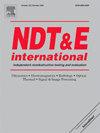Simulation and experimental research on magnetic detection technology for closed crack defects of superalloys
IF 4.5
2区 材料科学
Q1 MATERIALS SCIENCE, CHARACTERIZATION & TESTING
引用次数: 0
Abstract
Closed cracks in superalloy components are characterized by their small scale, concealment, and irregularity, presenting significant challenges for accurate non-destructive testing (NDT). This study introduces magnetic detection technology and demonstrates its efficacy in detecting closed cracks through numerical simulations, model experiments, and a particle swarm optimization-support vector machine (PSO-SVM) classification method. Simulations were conducted to investigate the magnetic response characteristics of closed cracks with varying depths and sizes. Subsequently, the influence of excitation frequency and probe scanning direction on defect responses was analyzed. Using a custom-designed magnetic detection instrument, artificial groove defects in superalloys were tested, and a classification framework for closed crack defects was established. The results reveal a linear correlation between the abnormal signal amplitude and defect parameters, including depth, size, excitation frequency, and scanning direction. Experimental validation confirmed the effectiveness of the magnetic detection technology for identifying closed cracks with burial depths less than 5 mm. Additionally, the optimized PSO-SVM classification method achieved an average accuracy of 98.11 % for defect classification and 92 % for quantification. These findings provide critical theoretical and technical insights into the detection of closed cracks in superalloys.
高温合金闭合裂纹缺陷磁检测技术的仿真与实验研究
高温合金部件的闭合裂纹具有规模小、隐蔽性和不规则性等特点,给精确无损检测(NDT)带来了重大挑战。本研究引入磁检测技术,并通过数值模拟、模型实验和粒子群优化-支持向量机(PSO-SVM)分类方法验证了磁检测技术在检测闭合裂纹中的有效性。对不同深度、不同尺寸闭合裂纹的磁响应特性进行了模拟研究。分析了激励频率和探针扫描方向对缺陷响应的影响。利用自行设计的磁探伤仪对高温合金中的人工沟槽缺陷进行了检测,建立了封闭裂纹缺陷的分类框架。结果表明,异常信号幅值与缺陷参数(深度、尺寸、激励频率和扫描方向)呈线性相关。实验验证了磁探技术对埋藏深度小于5 mm的封闭性裂缝识别的有效性。此外,优化后的PSO-SVM分类方法对缺陷分类的平均准确率为98.11%,对量化的平均准确率为92%。这些发现为高温合金中闭合裂纹的检测提供了重要的理论和技术见解。
本文章由计算机程序翻译,如有差异,请以英文原文为准。
求助全文
约1分钟内获得全文
求助全文
来源期刊

Ndt & E International
工程技术-材料科学:表征与测试
CiteScore
7.20
自引率
9.50%
发文量
121
审稿时长
55 days
期刊介绍:
NDT&E international publishes peer-reviewed results of original research and development in all categories of the fields of nondestructive testing and evaluation including ultrasonics, electromagnetics, radiography, optical and thermal methods. In addition to traditional NDE topics, the emerging technology area of inspection of civil structures and materials is also emphasized. The journal publishes original papers on research and development of new inspection techniques and methods, as well as on novel and innovative applications of established methods. Papers on NDE sensors and their applications both for inspection and process control, as well as papers describing novel NDE systems for structural health monitoring and their performance in industrial settings are also considered. Other regular features include international news, new equipment and a calendar of forthcoming worldwide meetings. This journal is listed in Current Contents.
 求助内容:
求助内容: 应助结果提醒方式:
应助结果提醒方式:


